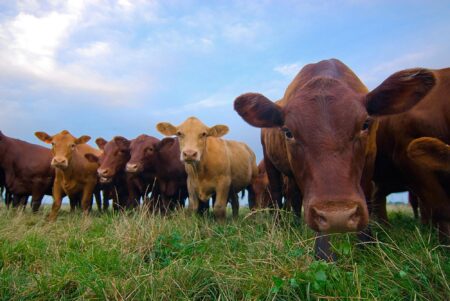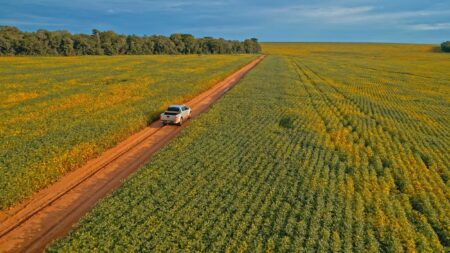Canadian CPA-turned-farmer Kristjan Hebert explains why scale matters for farm succession, how his business system helps manage growth, and the surprising ROI of technology and logistics. He shares practical tips every farmer can start using today.
15 Minutes With Kristjan Hebert
Subscribe to 15 Minutes With a Farmer on Apple Podcasts, Spotify, or wherever you listen to podcasts. Please rate and review us!
Meet Kristjan Hebert
Hebert grew up on his family’s small farm in southeast Saskatchewan, earned an accounting degree from the University of Saskatchewan in 2004, then completed his CPA certification. While working as a CPA, Hebert realized the business he was really interested in was the family farm. “It was probably the numbers side of farming that brought me back even more than the farm itself. I saw a lot of opportunity in it,” he said.
When Hebert came home, the farm consisted of 300 acres; today, it is around 41,000. As managing partner of Hebert Grain Ventures (HGV), he farms alongside his wife and parents. He is president and CEO of The Hebert Group, which includes HGV, Maverick Ag Consulting, Farmer Coach, and multiple nonprofit foundations. He also hosts the podcast The Truth About Ag.
Farming Like a CPA
Hebert uses an entrepreneurial operating system (EOS) to manage his business, and said it’s a framework that can be very beneficial to farmers. It consists of setting a 10-year goal, then breaking it down into 3-year, 1-year, trimester, monthly, and weekly goals.
“Using a system like this lets your people actually know the most important thing they’re working on today, this week, this month, and this year, because they can’t give you their best effort if they actually have no idea which way they’re going,” he said. “We have a weekly scorecard that both the management team and the ops team look at, right down to what our repairs are trending at compared to budget.”
The EOS also gives Hebert and his team a place to compile issues and get to the root of the problem. “Issues are most likely due to a bad process, which is usually caused by bad communication,” he said. “If you don’t track those issues, you’ll never fix anything, but if you deal with just three or four of them every week, it’s amazing how fast you can start improving the system your business runs on.”
The Benefits of Growth
Hebert said scaling to this degree may not be for everyone, but growing does play an important role in the success of farm businesses. “I go back to just simple economics. Inflation is 3-5%, so if you’re not growing at 3-5%, you’re actually going backwards every year,” he said.
But growth is about more than the immediate bottom line. “I think scale’s big for succession,” Hebert said. “I think a lot of succession plans fail because a son or daughter comes home and there just simply isn’t enough income for two families because the farm’s the same size it was 20 years ago when Mom and Dad needed that same income.”
Having a larger operation also means employees can have more defined roles. “Not many people in this world want to come to work every day and their job description is, ‘Do whatever I tell you,’ but on most farms, that is what it is,” he said. “I can have a mechanic on mechanic duty 70% of the year, then drive truck and equipment and help out with the crew the other 30%.”
Regardless of the amount of growth a farmer seeks, Hebert said mindset is important: “Growth can fix a lot of problems for you as long as you focus on people first. If you do it a little backwards, it can be quite painful.”
Inspiration For Growth
Hebert said his children inspired him to scale the farm like he did. When he hired a chief operating officer for HGV 8 years ago, the farm was at 8,000 acres, and they aimed to double in size in 6 years, a goal which was far exceeded.
“The real reason why we kept growing is family. I don’t ever want this thing to be sold, but what if my kids don’t want [to farm or be CEO]? Well, then it has to be set up large enough and as a business that I could have an outside management team running it,” he said. “At 8,000 or 10,000 acres, I didn’t think there was enough profit there to do that and still pay dividends to the family.”
Growth also benefits Hebert’s family life because he’s able to have enough employees that he can take time to coach youth hockey and take vacations. “If experiences with your kids and your wife make you happy, then you better find a way to get away from your business, and the easiest way that I’ve found to do that is to scale and have great people that understand that that’s important to you,” he said.
Hebert said he learned the hard way to be willing to grow. He was renting a piece of land a decade ago and passed on the opportunity to buy it. Now he drives past that land and regrets letting it go.
“Obviously land prices were a lot less then and I thought they wanted too much. We made a new rule that if it touches what we farm or it’s inside our circle, we’re really interested,” he said. “We’ve never really gone looking for growth. We’ve changed our mindset that we’re always open to growth.”
Takeaways for Farmers of All Sizes
Hebert says the EOS he uses can benefit all farmers. “It doesn’t really matter what size you are. Having that system of 10, 3, and 1-year goals and then breaking it down into trimesters is good for everybody,” he said. “Remember to include personal goals with your business goals.”
Having a solid sense of ROI is also key, he said:. “The easy ones are things like variable rate and sectional control, but sometimes the unknown ROI — specifically when you scale it — is logistics efficiency and ROI from technology.”
Hebert has found success thinking like a CPA, but he advises farmers to think like a banker too. “Probably the number one thing to look at is what your bank needs to understand,” he said. “Make sure you have a full comprehension of working capital, debt service, and those types of items, and how you can improve them. Because as those improve, that’s going to allow you to scale or take opportunities.”
Episode Highlights
- Hebert shares how his background as a CPA shaped his approach to farm management.
- The Hebert family farm grew from a few hundred acres to 41,000 through strategic scaling.
- He explains why growth is essential for succession planning and employee development.
- Hebert uses the Entrepreneurial Operating System (EOS) to guide decision-making.
- He views the farm as a project management operation with measurable short-term goals.
- Treating farming like a business—not just a lifestyle—allows for more flexibility and family time.
- Hebert emphasizes the importance of full-time staff for continuity and performance.
- A missed land deal taught him to always be open to growth opportunities.
- Technology delivers unexpected ROI, especially in logistics and efficiency management.







:max_bytes(150000):strip_icc()/KristjanHebert-d024136ec25b482eb920d5ae13362c38.jpg)



:max_bytes(150000):strip_icc()/Markets-7-Corn-up-soybeans-down-8-0a75579f8d7040eebf2a30c978a1c63c.jpeg)

:max_bytes(150000):strip_icc()/54778662706_5ab262825b_o-68d3addad1aa4d36911c1d80274538a9.jpg)